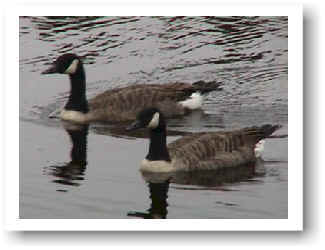
Canada Geese
Branta canadensis
Status
Native to Newfoundland and Labrador.
Habitat
Barren land and marshes where berries and plants are abundant; lakes, streams, bays, riversides, and coastal estuaries.
Range
Breeding range of the Canada Goose extends from northern Canada south to St. Lawrence River and north central states. Canada’s winter from southern Canada to the Gulf of Mexico.
Food
Their primary diet is wild berries such as blueberry, partridge berry, and marsh berry; They also feed on grass, grains, aquatic plants and will occasionally eat insects and their larva, crustaceans, small clams, snails and small fish when abundant.
Predators/Threats
Canada Geese are preyed upon by Foxes, Lynx, Golden and Bald Eagles. They also represent an important food source for hunters throughout North America.
Lifespan
Canada Geese may live from 20-30 years in captivity, considerably less in the wild.
Appearance
The Canada Goose has a black head and neck; grey-brown body; white cheek patches which join under the chin; black feet, legs and bill.
Breeding Biology
Canada Geese mate for life. They lay from 4-10 eggs (usually 5-6) which are dull or dirty white in color. Incubation by the female takes 28-30 day, during which time the male will remain close by to protect the nest by driving away intruders.
Average Weight/Measurements
Depending on the race, weights will vary from (2.4 – 17.6 lbs)(1.1 – 8 kg).; length of (2 – 3.4 ft)(55.8 – 101.6 cm); and a wingspan of approximately (3 ft)(90 cm) to (6.6 ft)(2 m).
Notes:
- Canada Geese are known for its V-shape formation during long flights.
- They are a much sought after food because of their large size and delicate flesh.
- Contrary to its heavy, cumbersome appearance during flight, the Canada Goose moves at astonishing speed while airborne.
- Canada Geese represent one of the best examples of successful waterfowl management in North America.
- The Avalon Wilderness Area has a large breeding population of Canada Geese.
At Salmonier Nature Park
- The park usually displays around a dozen Canada Geese.
- In any given year at least one pair will successfully hatch and raise young.
